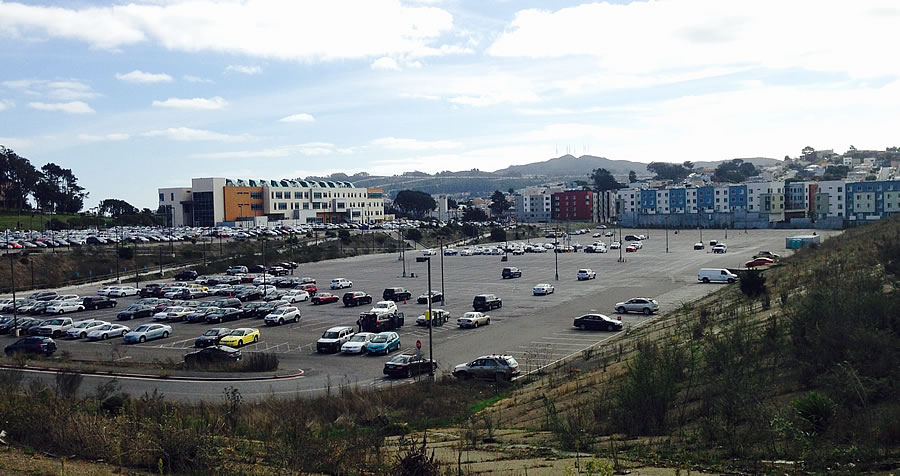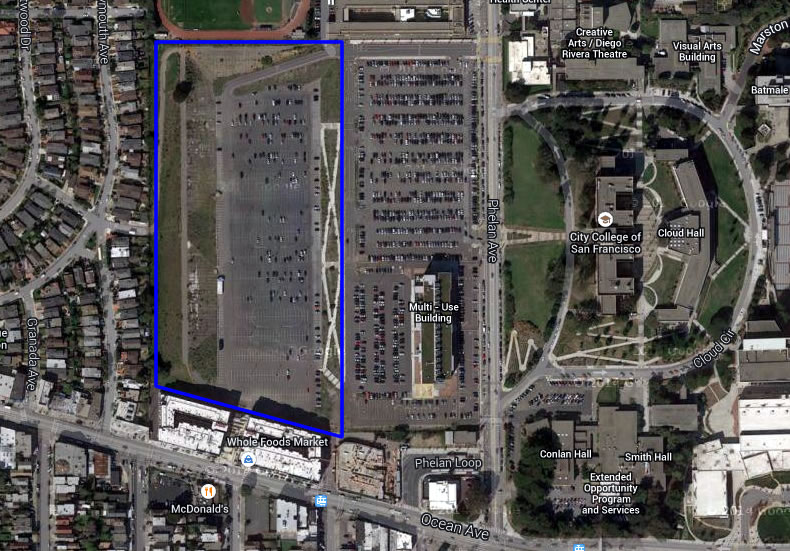While all the teams interested in buying, entitling and redeveloping the western 17 acres of the Balboa Reservoir site, which is currently a 1,000-space parking lot under the jurisdiction of the San Francisco Public Utilities Commission, have submitted their qualifications and preliminary concepts to the City, the finalists will not be announced this Friday as originally slated but rather on Friday, March 10.
The reservoir, which is currently designated for “Public” use with a height limit of 40 feet in height, will need to be re-zoned. And based on years of community input and planning, the rough parameters and expectations for the site call for building heights of 25 to 65 feet, with at least 50% of all proposed housing to be designated as permanently affordable to households with incomes of 55 to 150 percent of the Area Median and 4 acres of new parks and open space.
In addition, the finalists will be expected to collaborate with City College, which borders the property, in areas such as parking, transportation and congestion management.
The Balboa Park Reservoir, which represents one of the largest underdeveloped sites in the city, was built in the 1950’s, has never held a drop of water, and is one of San Francisco’s Public Lands for Housing sites identified for priority redevelopment (back in 2014).


Sure, it is not like we need more housing right at this minute…..
Used to live over there on brighton st, always thought it was weird to see a walmart sized parking lot in san francisco. Hopefully whatever is proposed turns out great.
I’ve never understood this. Is there actually an empty cistern underneath the parking surface or was the “reservoir” never really built?
It’s built, never used. There’s a dam on one side but the bottom is just pavement.
@Socketsite do we know anything about the reasons for the push back?
Why is there so much fear to build ‘up’ in any part of town outside of downtown, and especially in the outer neighborhoods like this. If there’s anywhere in the city that could support hundreds and hundreds of new units, it’s here.
This site is surrounded by a plethora of amenities, it is practically on top of a local transit hub, only a few blocks away from a regional transit hub, a two-minute drive to the freeway, and immediately adjacent to several education institutions including City College, which collectively serve tens of thousands of students every day.
It’s not like this out in the distant exurbs, so why limit it to only 65 feet tall? Geez, you would think there was no housing demand or something.
anon2, what you said is totally reasonable and makes sense. Keep saying it. Call your Supervisor and say it. Email Planning Commissioners and say it. Come to community meetings and neighborhood association meetings and say it. That’s how we change the slow-growth mentality in San Francisco, because you’re exactly right, but no one was loudly, visibly and consistently saying these things until the Yimby movement emerged in the last two years.
I want to develop this site, but we might be confusing a few things. Just to clarify – 90% of the push-back on this project has been about the type of housing built and the needed transit infrastructure that the city should be building, not pure resistance to building. The media narrative that local residents just don’t want anything built is lazy and incorrect. What locals actually want is for the city to promise to fix our infrastructure to accommodate everyone in the area.
3 biggest issues:
1.) At one point, the plan was to build a parking garage on half of the land, with housing next to it. Off the bat, most of us can see why that was a terrible idea. After push back, more apartments have been added to replace much of the parking garages.
2.) Original plan was for 15%-20% affordable housing, using city-owned land. If we’re going to build affordable housing anywhere in the city, should large lots of gov-owned land be the prime target? After push back, “affordable” housing has been expanded to 50%, but the definition they’re using for affordable is households earning up to $130k/year, which I think is too high. More work to be done here.
3.) The “local transit hub” anon2 describes is a mess. If you’ve been there during the morning or evening, the congestion rivals down town because Ocean and Geneva Ave collect too much traffic from all the local avenues. Public transit (bus) is ineffective with this type of congestion (and not enough bus lines) and Balboa Park BART is not walkable from the Reservoir on the other side of the highway. Critics are pushing for the city to re-route traffic in that area, and MUNI to add more lines, but there are limits to capacity.
About YIMBY: They fight for construction, but don’t fight for affordability, public transit, and infrastructure with the same energy. These issues aren’t separated. Let’s be honest that the folks leading the YIMBY groups are funded by construction companies, and so the pressure is on their shoulders to acutely focus on building instead of capacity as a whole. When someone (like me) comes out and says “hey, you need to consider transit before you build”, the YIMBYs become very defensive. I want to develop that area too, but I know that the planning phase is the only time we can put the pressure on the city to actually improve transit, etc., because they’re stuck between developers and constituents. If YIMBYs spent more time working with opposition instead of claiming that SFers just don’t want to build housing, we’d have a better, more functional city.
this is a very nice comment. im pro new construction too, but the city has done nothing to improve transit over the past 20 years. there should be at least 5 subway lines across SF, but instead we go for painted bus lanes and new bike lanes, which both increase congestion even more. public transportation needs to be taken either below or above street level
Adding 2000 smallish units of “market rate” housing would do more to improve affordability than adding 500 units that were 60% “affordable” (subsidized by the other 40%). More supply is the best answer, not making it ever more expensive and difficult to add supply. A large number of new small units will draw renters from existing older small units and help lower the market price for those older small units to make them more affordable for those who can’t afford big, new apartments. It’s better to help working class renters afford those places through rent subsidies.
I grew up dirt poor living in a small rental unit. Using government funds to give my family a big new place would have been really cool, for me, but the same money could have subsidized 3 or 4 families to get into smallish older housing and would have been a better use of resources. Sure, the developers pay for the affordable housing mandates, but there’s no free lunch. The money they spend on it means that their market rate units need to be geared to attract top dollar, and there are other concessions that the City isn’t getting because it’s getting as much as it can from developers to subsidize half the units.
Giving a handful of lucky working-class people large new luxury apartments (OK, I’m exaggerating a bit) is just a terrible policy. Why not let developers pay a fee to avoid the affordable mandate and use the money to subsidize four times as many families to find housing in lower-priced older housing stock?
The solution to a tight housing market is to promote the building of housing. The best treatment (not really a solution) to poverty is more income redistribution, not giving away expensive stuff to a handful of lucky poor people through a lottery, which coincidentally is often won by politically connected people.
Anon, are you new to the city?
Do you know that all your reason and common sense quickly pales when portrait-ed as a ‘threat to neighborhood character’? Just look at the tidy, semi-detached homes in the Westwood Park neighborhood that go for 1.5-2.5m a piece. Do you think these peeps will sit by idly if a new development could potentially knock a single dollar out of their property’s value? Welcome to the city of tolerance and progressive transportation policies.*
*That is, tolerant and progressive as long as it doesn’t impact me or my lifetime savings in any shape or form.
Pero, Unfortunately, I think you are 100% on the money here.
When I went to CCSF, the reservoirs were two depressed bowls, one north and one south. The north one was used as a parking lot and the south one was empty. After it rained, a corner of the south reservoir held a large puddle of water.
Word on the street is that Thomas Kinkade is going to be the architect of the new design.
Phelan and Ocean are bogged down with traffic, TMD is being proposed, but there is no infrastructure solution on the parking needs for CCSF as they are still in initial planning modes. The need is to directly connect to the entry to Balboa Station BART, and redesign the BART MUNI connection at this hub to service ever increasing growth… A high-line or better designed “route” to the entry is needed vs. walking the gutter that is the current ocean ave from Phelan down to the BART station… it needs better safety, lighting and crossing of the hwy.
Pedestrian conditions in that area are surprisingly terrible given the amount of transit that comes together there. Perhaps the developers could be shaken down to improve that and for some cash to pass on as rent subsidies, instead of the economically illiterate affordable housing mandates (expensive housing cheap for lottery-winning poor people is both enormously inefficient and promotes corruption).
Not to mention most of the community wants the PAEC building built, and efforts at open-space not solid block of housing like Avalon…
What the community wants and what someone will build are two different things.
CCSF has nowhere near the money to build the PAEC so that shouldn’t be a factor – they need to put up or shut up. I think it would be reasonable to require the developers to add multi-level parking for CCSF, maybe on the part owned by the college. SFMTA has a whole plan to improve the connections from Phelan to the BART, but there really isn’t much they can do on the Geneva side. Maybe this development will help spur that.
While I will support development here, I don’t know that tall towers are the best solution, given all the transportation challenges. I think a mix of mid-rise, townhomes, and maybe attached SFRs would work.
How many times over the past 20 years have I read that same headline?
UPDATE: Three Teams in the Running for Balboa Reservoir Redevelopment